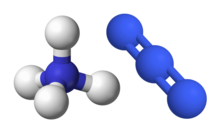Ammonium azide
Appearance

| |

| |
| Names | |
|---|---|
| Other names
Ammonium trinitride
| |
| Identifiers | |
3D model (JSmol)
|
|
| ChemSpider | |
| ECHA InfoCard | 100.032.093 |
| EC Number |
|
PubChem CID
|
|
CompTox Dashboard (EPA)
|
|
| |
| |
| Properties | |
| NH4N3, NH3.HN3 | |
| Molar mass | 60.059 g/mol |
| Appearance | White crystalline solid |
| Odor | Odorless |
| Density | 1.3459 g/cm3 |
| Melting point | 160 °C (320 °F; 433 K) |
| Boiling point | 400 °C (752 °F; 673 K) (decomposes) |
| Structure[1] | |
| orthorhombic | |
| Pman | |
a = 8.930, b = 8.642, c = 3.800
| |
Formula units (Z)
|
4 |
| Hazards | |
| Occupational safety and health (OHS/OSH): | |
Main hazards
|
Very toxic, explosive |
| Related compounds | |
Other anions
|
Ammonium nitrate Ammonium cyanide |
Other cations
|
Sodium azide Potassium azide |
Except where otherwise noted, data are given for materials in their standard state (at 25 °C [77 °F], 100 kPa).
| |
Ammonium azide is the chemical compound with the formula NH4N3, being the salt of ammonia and hydrazoic acid. Like other inorganic azides, this colourless crystalline salt is a powerful explosive, although it has a remarkably low sensitivity. NH4N3 is physiologically active and inhalation of small amounts causes headaches and palpitations. It was first obtained by Theodor Curtius in 1890, along with other azides.
Structure
Ammonium azide is ionic. Ammonium azide contains about 93% nitrogen by weight as ammonium cation and azide anion. It is a structural isomer of tetrazene.
References
- ^ Frevel, Ludo K. (1 January 1936). "The Crystal Structure of Ammonium Azide, NH4N3". Zeitschrift für Kristallographie - Crystalline Materials. 94 (1–6): 197. doi:10.1524/zkri.1936.94.1.197.
- Yakovleva, G. S.; Kurbangalina, R. Kh.; Stesik, L. N. (1977). "Detonation properties of ammonium azide". Combustion, Explosion, and Shock Waves. 13 (3): 405. doi:10.1007/BF00740326.
- Salim de Amorim, Helio; do Amaral, M. R.; Pattison P.; Ludka I. P.; Mendes, J. C. (2002). "Ammonium azide: A Commented Example of an Ab Initio Structure (Re-)Determination From X-Ray Diffraction" (PDF). Revista de la Sociedad Quimica de México. 45 (4): 313–319. Archived (PDF) from the original on 2012-04-06.
- Curtius, Th. (1890). "Ueber Stickstoffwasserstoffsäure (Azoimid) N3H". Berichte der Deutschen Chemischen Gesellschaft. 23 (2): 3023–3033. doi:10.1002/cber.189002302232.
